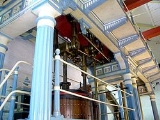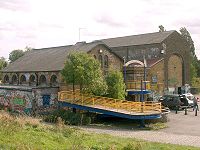
Markfield Beam Engine
Encyclopedia

Horsepower
Horsepower is the name of several units of measurement of power. The most common definitions equal between 735.5 and 750 watts.Horsepower was originally defined to compare the output of steam engines with the power of draft horses in continuous operation. The unit was widely adopted to measure the...
beam
Beam engine
A beam engine is a type of steam engine where a pivoted overhead beam is used to apply the force from a vertical piston to a vertical connecting rod. This configuration, with the engine directly driving a pump, was first used by Thomas Newcomen around 1705 to remove water from mines in Cornwall...
pumping engine
Stationary engine
A stationary engine is an engine whose framework does not move. It is normally used not to propel a vehicle but to drive a piece of immobile equipment such as a pump or power tool. They may be powered by steam; or oil-burning or internal combustion engines....
, built in 1886 to transfer sewage
Sewage
Sewage is water-carried waste, in solution or suspension, that is intended to be removed from a community. Also known as wastewater, it is more than 99% water and is characterized by volume or rate of flow, physical condition, chemical constituents and the bacteriological organisms that it contains...
from the Middlesex
Middlesex
Middlesex is one of the historic counties of England and the second smallest by area. The low-lying county contained the wealthy and politically independent City of London on its southern boundary and was dominated by it from a very early time...
district of Tottenham
Tottenham
Tottenham is an area of the London Borough of Haringey, England, situated north north east of Charing Cross.-Toponymy:Tottenham is believed to have been named after Tota, a farmer, whose hamlet was mentioned in the Domesday Book; hence Tota's hamlet became Tottenham...
into the London
London
London is the capital city of :England and the :United Kingdom, the largest metropolitan area in the United Kingdom, and the largest urban zone in the European Union by most measures. Located on the River Thames, London has been a major settlement for two millennia, its history going back to its...
system for treatment at the Beckton
Beckton
Beckton is part of the London Borough of Newham, England, located east of Charing Cross.Its boundaries are the A13 trunk road to the north, Barking Creek to the east, the Royal Docks to the south, and Prince Regent Lane to the west. The area around Prince Regent Lane is also known as Custom House...
works.
The engine is housed in a Grade II listed building, "Engine House No. 2", and, having been restored to working order, the engine is the main feature of Markfield Museum.
The museum is sited on the northern edge of Markfield Park, a large public open space.
History
The Tottenham and Wood Green sewage treatment works and pumping station was opened in 1864 .The Markfield Beam Engine itself was built between 1886 and 1888. It was commissioned on the 12th July 1888 and saw continuous duty from that time until late in 1905, when it was relegated to standby duty for stormwater
Stormwater
Stormwater is water that originates during precipitation events. It may also be used to apply to water that originates with snowmelt that enters the stormwater system...
pumping.

London County Council
London County Council was the principal local government body for the County of London, throughout its 1889–1965 existence, and the first London-wide general municipal authority to be directly elected. It covered the area today known as Inner London and was replaced by the Greater London Council...
meant that it was more cost-effective to have all effluents directed through a new low-level sewer to the rebuilt Deephams Sewage Treatment Works
Deephams Sewage Treatment Works
Deephams Sewage Treatment Works is a sewage treatment facility close to Picketts Lock, Edmonton. The outflow discharges via Pymmes Brook into the River Lee Navigation at Tottenham Lock. The treatment works is in the process of being upgraded ....
at Edmonton
Edmonton
Edmonton is the capital of the Canadian province of Alberta and is the province's second-largest city. Edmonton is located on the North Saskatchewan River and is the centre of the Edmonton Capital Region, which is surrounded by the central region of the province.The city and its census...
. Thus pumping of sewage would no longer be required at the Markfield Works.
In 1964, after more than one hundred years of operation, all the incoming sewers were diverted to the extended East Middlesex Works at Deephams.
The works were closed and all machinery, apart from the Beam Engine, was scrapped. The site was levelled, apart from the engine house buildings and the settling tanks and filter beds. The engine house was made secure and the Beam Engine mothballed.
The former sludge tanks were turned into a communal garden space, however due to neglect and poor security, the entire area was extensively vandalised and allowed to become overgrown.
A full restoration of the entire park was completed by April 2010 and the park and museum and beam engine re-opened for public access.
The engine - technical details
The beam engine is a free-standing engineSteam engine
A steam engine is a heat engine that performs mechanical work using steam as its working fluid.Steam engines are external combustion engines, where the working fluid is separate from the combustion products. Non-combustion heat sources such as solar power, nuclear power or geothermal energy may be...
of the compound rotative type. It is believed to be the last engine produced by Wood Bros. of Sowerby Bridge
Sowerby Bridge
Sowerby Bridge is a market town that lies within the Upper Calder Valley in the district of Calderdale in the county of West Yorkshire, in northern England.-Geography:Sowerby Bridge is situated on the edge of Halifax, about three miles from its centre...
, Yorkshire
Yorkshire
Yorkshire is a historic county of northern England and the largest in the United Kingdom. Because of its great size in comparison to other English counties, functions have been increasingly undertaken over time by its subdivisions, which have also been subject to periodic reform...
. It is the only surviving eight-column engine in its original location. The engine has two cylinders arranged to be double-acting and compounded.
The engine's beam drives two pumps of the single-acting plunger type. Each pump is 26" diameter and 51" stroke. At a working speed of 16rpm, these pumps could handle 4 million gallons in 24 hours over a relatively low head. The engine's flywheel
Flywheel
A flywheel is a rotating mechanical device that is used to store rotational energy. Flywheels have a significant moment of inertia, and thus resist changes in rotational speed. The amount of energy stored in a flywheel is proportional to the square of its rotational speed...
is 27 feet in diameter and weighs around 17 tons.
The engine features a speed governor of the Watt
James Watt
James Watt, FRS, FRSE was a Scottish inventor and mechanical engineer whose improvements to the Newcomen steam engine were fundamental to the changes brought by the Industrial Revolution in both his native Great Britain and the rest of the world.While working as an instrument maker at the...
Centrifugal type and its drive coupling to the cylinders is of the conventional Watt parallel motion
Parallel motion
The parallel motion is a mechanical linkage invented by the Scottish engineer James Watt in 1784 for his double-acting steam engine.In previous engines built by Newcomen and Watt, the piston pulled one end of the walking beam downwards during the power stroke using a chain, and the weight of the...
Linkage.
The engine is finely decorated, according to the fashion of the day, with doric
Doric order
The Doric order was one of the three orders or organizational systems of ancient Greek or classical architecture; the other two canonical orders were the Ionic and the Corinthian.-History:...
columns and acanthus
Acanthus (ornament)
The acanthus is one of the most common plant forms to make foliage ornament and decoration.-Architecture:In architecture, an ornament is carved into stone or wood to resemble leaves from the Mediterranean species of the Acanthus genus of plants, which have deeply cut leaves with some similarity to...
leaves. There are also three finely ornate iron vases atop the valve chest. Its original colours, it is believed, were light and dark green with all exposed metalwork being highly polished and oiled.
Restoration
Since the engine was mothballed in February 1964, and the surrounding site was levelled, the area had seen significant decay and vandalism. It was estimated that a complete restoration of the engine would cost an additional £25,000.The engine was partially restored and painted to a moving condition. A steam generator was fitted in a new boiler house annexe in the early 1980s but later broke down.
By April 2010 a complete overhaul and restoration had been completed. 2 new oil fired boilers were installed and a seized pump fixed to bring the engine to running condition. September 2009 saw the first public steaming of the engine in the restored engine house.
Whereas the 1980s partial restoration had seen a blue and white colour scheme employed this has now been changed to a more original dark green.
Several minor additions to the engine were removed to more accurately reflect its working life condition.
Regeneration
Haringey Council planned a major project to regenerate Markfield Park. A key part of the £1.5 million project was the restoration of the beam engine to full working order, and the development of the museum to provide better educational facilities for the area. An initial £22900 was awarded to the council by the Heritage Lottery FundHeritage Lottery Fund
The Heritage Lottery Fund is a fund established in the United Kingdom under the National Lottery etc. Act 1993. The Fund opened for applications in 1994. It uses money raised through the National Lottery to transform and sustain the UK’s heritage...
in May 2007, for the purposes of developing detailed plans for Stage 2 of the application for the remainder of the funding.
The restoration included the replacement of all the pumphouse windows, which were bricked-up since 1964 in an effort to secure the beam engine from vandalism. (Plans showing the new museum complex may be found on the Official Website.)

